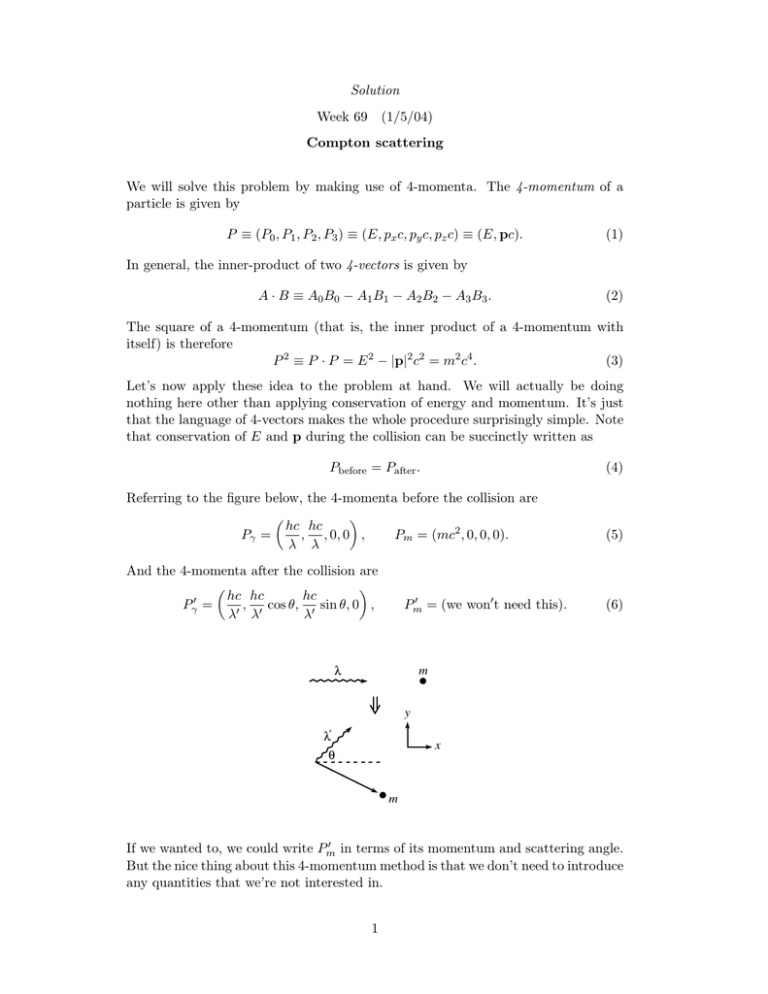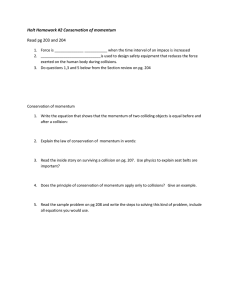Solution Week 69 (1/5/04) Compton scattering We will solve this
advertisement

Solution Week 69 (1/5/04) Compton scattering We will solve this problem by making use of 4-momenta. The 4-momentum of a particle is given by P ≡ (P0 , P1 , P2 , P3 ) ≡ (E, px c, py c, pz c) ≡ (E, pc). (1) In general, the inner-product of two 4-vectors is given by A · B ≡ A0 B0 − A1 B1 − A2 B2 − A3 B3 . (2) The square of a 4-momentum (that is, the inner product of a 4-momentum with itself) is therefore P 2 ≡ P · P = E 2 − |p|2 c2 = m2 c4 . (3) Let’s now apply these idea to the problem at hand. We will actually be doing nothing here other than applying conservation of energy and momentum. It’s just that the language of 4-vectors makes the whole procedure surprisingly simple. Note that conservation of E and p during the collision can be succinctly written as Pbefore = Pafter . (4) Referring to the figure below, the 4-momenta before the collision are µ Pγ = ¶ hc hc , , 0, 0 , λ λ Pm = (mc2 , 0, 0, 0). (5) And the 4-momenta after the collision are µ Pγ0 = ¶ hc hc hc , 0 cos θ, 0 sin θ, 0 , 0 λ λ λ 0 Pm = (we won0 t need this). λ (6) m y λ' θ x m 0 in terms of its momentum and scattering angle. If we wanted to, we could write Pm But the nice thing about this 4-momentum method is that we don’t need to introduce any quantities that we’re not interested in. 1 0 . Therefore, Conservation of energy and momentum give Pγ + Pm = Pγ0 + Pm 02 (Pγ + Pm − Pγ0 )2 = Pm 2 02 =⇒ Pγ2 + Pm + Pγ02 + 2Pm (Pγ − Pγ0 ) − 2Pγ Pγ0 = Pm µ ¶ hc hc hc hc =⇒ 0 + m2 c4 + 0 + 2mc2 − 0 −2 (1 − cos θ) = m2 c4 . λ λ λ λ0 (7) Multiplying through by λλ0 /(2hmc3 ) gives the desired result, λ0 = λ + h (1 − cos θ). mc (8) 0 The ease of this solution arose from the fact that all the unknown garbage in Pm disappeared when we squared it. Remarks: 1. If θ ≈ 0 (that is, not much scattering), then λ0 ≈ λ, as expected. 2. If θ = π (that is, backward scattering) and additionally λ ¿ h/mc (that is, mc2 ¿ hc/λ = Eγ ), then λ0 ≈ 2h/mc, so Eγ0 = hc 1 hc ≈ 2h = mc2 . 0 λ 2 mc (9) Therefore, the photon bounces back with an essentially fixed Eγ0 , independent of the initial Eγ (as long as Eγ is large enough). This isn’t all that obvious. 2




